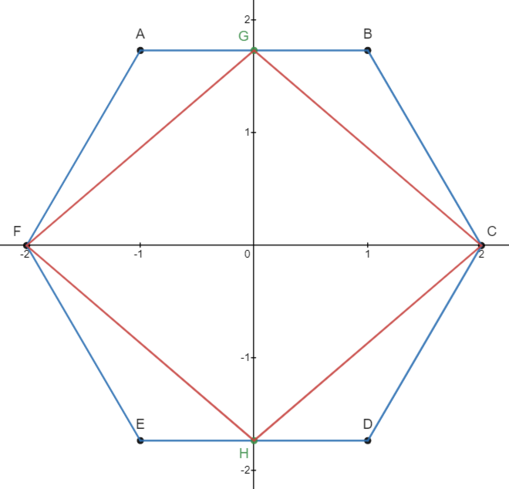Difference between revisions of "2022 AMC 12B Problems/Problem 10"
Mathboy100 (talk | contribs) (→Solution 1 (No trig)) |
(→Solution 2) |
||
| Line 31: | Line 31: | ||
Note: The sum of the interior angles of any polygon with <math>n</math> sides is given by <math>180 ^{\circ} (n - 2)</math>. Therefore, the sum of the interior angles of a hexagon is <math>720 ^{\circ}</math>, and each interior angle of a regular hexagon measures <math>\frac{720 ^{\circ}}{6} = 120 ^{\circ}</math>. | Note: The sum of the interior angles of any polygon with <math>n</math> sides is given by <math>180 ^{\circ} (n - 2)</math>. Therefore, the sum of the interior angles of a hexagon is <math>720 ^{\circ}</math>, and each interior angle of a regular hexagon measures <math>\frac{720 ^{\circ}}{6} = 120 ^{\circ}</math>. | ||
| + | |||
| + | == Solution 3 == | ||
| + | |||
| + | [[Image:2022 AMC 12B-10.PNG|thumb|right|509px|Image caption]] | ||
| + | We use a coordinates approach. Letting the origin be the center of the hexagon, we can let <math>A = (-1, \sqrt{3}), B = (1, \sqrt{3}), C = (2, 0), D = (1, -\sqrt{3}), E = (-1, -\sqrt{3}), F = (-2, 0).</math> Then, <math>G = (0, \sqrt{3})</math> and <math>H = (0, -\sqrt{3}).</math> | ||
| + | |||
| + | We use the distance formula four times to get <math>CH, HF, FG, \text{ and } GC.</math> | ||
| + | |||
| + | <cmath>CH^2 = (2-0)^2 + (0-(-\sqrt{3}))^2 = 7 \rightarrow CH = \sqrt{7}</cmath> | ||
| + | <cmath>HF^2 = (0-(-2))^2 + (-\sqrt{3}-0)^2 = 7 \rightarrow HF = \sqrt{7}</cmath> | ||
| + | <cmath>FG^2 = (-2-0)^2 + (0-\sqrt{3})^2 = 7 \rightarrow FG = \sqrt{7}</cmath> | ||
| + | <cmath>GC^2 = (0-2)^2 + (\sqrt{3}-0)^2 = 7 \rightarrow GC = \sqrt{7}</cmath> | ||
| + | |||
| + | Thus, the perimeter of <math>GCHF = CH + HF + FG + GC = \sqrt{7} + \sqrt{7} + \sqrt{7} + \sqrt{7} = \boxed{\textbf{(D)} \ 4\sqrt{7}</math>. | ||
| + | |||
| + | ~sirswagger21 | ||
| + | |||
| + | Note: the last part of this solution could have been simplified by noting that <math>CH = HF = FG = GC.</math> | ||
==Video Solution 1== | ==Video Solution 1== | ||
Revision as of 20:57, 20 November 2022
Problem
Regular hexagon ![]() has side length
has side length ![]() . Let
. Let ![]() be the midpoint of
be the midpoint of ![]() , and let
, and let ![]() be the midpoint of
be the midpoint of ![]() . What is the perimeter of
. What is the perimeter of ![]() ?
?
![]()
Solution 1 (No trig)
Let the center of the hexagon be ![]() .
. ![]() ,
, ![]() ,
, ![]() ,
, ![]() ,
, ![]() , and
, and ![]() are all equilateral triangles with side length
are all equilateral triangles with side length ![]() . Thus,
. Thus, ![]() , and
, and ![]() . By symmetry,
. By symmetry, ![]() . Thus, by the Pythagorean theorem,
. Thus, by the Pythagorean theorem, ![]() . Because
. Because ![]() and
and ![]() ,
, ![]() . Thus, the solution to our problem is
. Thus, the solution to our problem is ![]()
~mathboy100
Solution 2
Consider triangle ![]() . Note that
. Note that ![]() ,
, ![]() , and
, and ![]() because it is an interior angle of a regular hexagon. (See note for details.)
because it is an interior angle of a regular hexagon. (See note for details.)
By the Law of Cosines, we have:

By SAS Congruence, triangles ![]() ,
, ![]() ,
, ![]() , and
, and ![]() are congruent, and by CPCTC, quadrilateral
are congruent, and by CPCTC, quadrilateral ![]() is a rhombus. Therefore, the perimeter of
is a rhombus. Therefore, the perimeter of ![]() is
is ![]() .
.
Note: The sum of the interior angles of any polygon with ![]() sides is given by
sides is given by ![]() . Therefore, the sum of the interior angles of a hexagon is
. Therefore, the sum of the interior angles of a hexagon is ![]() , and each interior angle of a regular hexagon measures
, and each interior angle of a regular hexagon measures ![]() .
.
Solution 3
We use a coordinates approach. Letting the origin be the center of the hexagon, we can let ![]() Then,
Then, ![]() and
and ![]()
We use the distance formula four times to get ![]()
![]()
![]()
![]()
![]()
Thus, the perimeter of $GCHF = CH + HF + FG + GC = \sqrt{7} + \sqrt{7} + \sqrt{7} + \sqrt{7} = \boxed{\textbf{(D)} \ 4\sqrt{7}$ (Error compiling LaTeX. Unknown error_msg).
~sirswagger21
Note: the last part of this solution could have been simplified by noting that ![]()
Video Solution 1
~Education, the Study of Everything
See Also
| 2022 AMC 12B (Problems • Answer Key • Resources) | |
| Preceded by Problem 9 |
Followed by Problem 11 |
| 1 • 2 • 3 • 4 • 5 • 6 • 7 • 8 • 9 • 10 • 11 • 12 • 13 • 14 • 15 • 16 • 17 • 18 • 19 • 20 • 21 • 22 • 23 • 24 • 25 | |
| All AMC 12 Problems and Solutions | |
The problems on this page are copyrighted by the Mathematical Association of America's American Mathematics Competitions. 










